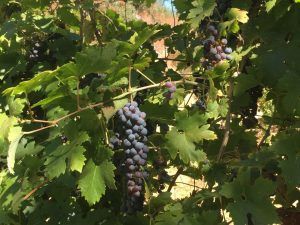Pruning your Grapes
Grapes are grown for many reasons: ornamental, shade arbors, fruit and wine. Each of these purposes requires a different approach to pruning. All of them share one thing in common: grape plants are the next thing to weeds; you have to be intentional to kill them.
Pruning for an arbor or fence top is easy, just trim to taste. Remember, you will most likely not get a lot of fruit and the berries will be small. Vines prefer to produce foliage and reproduce by rooting wherever they touch the ground. In the wild, a single vine can cover an acre and can pull down trees and bushes.
For fruit, you need to severely prune your vine. This method is called cane pruning. You train the vine to a head at the top of your stake next to the wire. To do this you tie a cane to the stake the first year and then top it just above a bud below the wire. Canes that emerge from this junction are what you want. Anything below is a sucker and needs to be pulled off while still green. If you cut it off, you leave behind a large number of buds which will continue to send out shoots. After the summer’s growth, and after the vines are dormant, you will have a number of canes coming from the head. Only the first year’s growth will produce fruit for the next year. The others should be pruned back to the head. First-year canes will be smooth and not have a true bark on them. Leave from two to four canes on each side of the head and tie them to the wire.
Wine grapes are cordon pruned (cordon means arm in French.) To do this, take two canes the first year and tie them to the wire. All other canes should be pulled off for they are considered to be suckers. After the first year when the arms are established, all the canes are pruned from the arms leaving behind a spur with two or three buds on it. It is from these spurs that you will get your grapes. Each spur will produce canes for foliage and grapes for wine. Another common way to refer to this kind of pruning is spur pruning.
These three methods cover the way most vines are pruned, but each varietal has its own method. For example, zinfandel should be cane pruned not spur pruned. Look up the varietal you want to grow to make sure of the pruning style that will give you the best yield. Another thing to keep in mind is summer pruning. Grapes are very susceptible to powdery mildew so the foliage needs to be thinned. Keep the canes from dragging on the ground. Prune all of them about a foot above ground level to provide air circulation. You may also need to thin the overhead canopy a little for the same reason. Don’t take too much or you can sunburn the fruit. If you end up with mildew anyway use sulfur.
Grapes are very versatile. You can eat them as a snack, in salads, dry them as raisins or make wine. It has been grown as a crop for thousands of years. If you have any questions that are garden- or grape-related, call the University of California Master Gardeners hotline at (209) 533-5912 or email us at mgtuolumne@ucdavis.edu.
Jim Bliss is a University of California Cooperative Extension (UCCE) Master Gardener of Tuolumne County.
UCCE Master Gardeners of Tuolumne and Calaveras Counties can answer home gardening questions. Call 209-533-5912 or fill out our easy-to-use problem questionnaire here. Check out our website here. You can also find us on Facebook.

